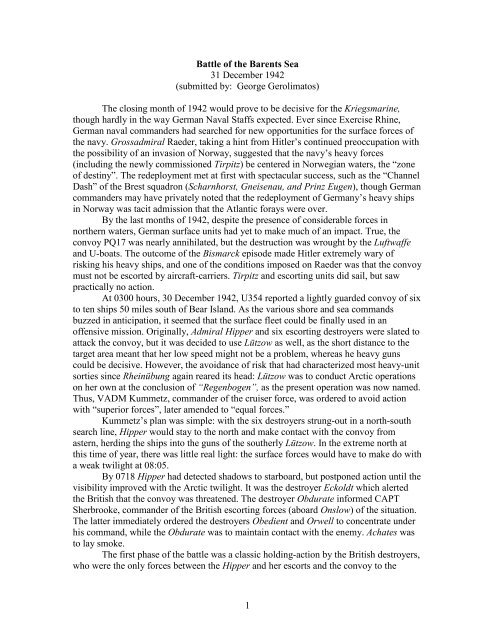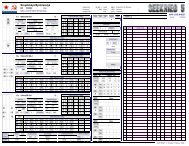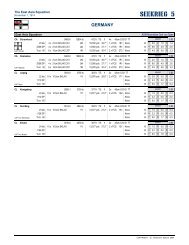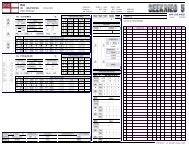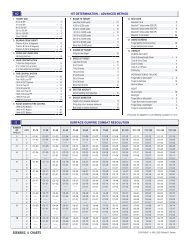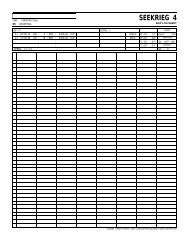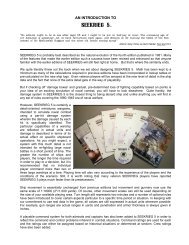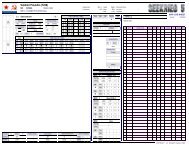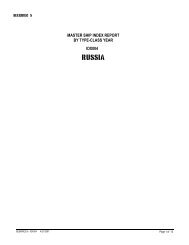Battle of the Barents Sea - Seekrieg Naval Wargame
Battle of the Barents Sea - Seekrieg Naval Wargame
Battle of the Barents Sea - Seekrieg Naval Wargame
You also want an ePaper? Increase the reach of your titles
YUMPU automatically turns print PDFs into web optimized ePapers that Google loves.
<strong>Battle</strong> <strong>of</strong> <strong>the</strong> <strong>Barents</strong> <strong>Sea</strong><br />
31 December 1942<br />
(submitted by: George Gerolimatos)<br />
The closing month <strong>of</strong> 1942 would prove to be decisive for <strong>the</strong> Kriegsmarine,<br />
though hardly in <strong>the</strong> way German <strong>Naval</strong> Staffs expected. Ever since Exercise Rhine,<br />
German naval commanders had searched for new opportunities for <strong>the</strong> surface forces <strong>of</strong><br />
<strong>the</strong> navy. Grossadmiral Raeder, taking a hint from Hitler’s continued preoccupation with<br />
<strong>the</strong> possibility <strong>of</strong> an invasion <strong>of</strong> Norway, suggested that <strong>the</strong> navy’s heavy forces<br />
(including <strong>the</strong> newly commissioned Tirpitz) be centered in Norwegian waters, <strong>the</strong> “zone<br />
<strong>of</strong> destiny”. The redeployment met at first with spectacular success, such as <strong>the</strong> “Channel<br />
Dash” <strong>of</strong> <strong>the</strong> Brest squadron (Scharnhorst, Gneisenau, and Prinz Eugen), though German<br />
commanders may have privately noted that <strong>the</strong> redeployment <strong>of</strong> Germany’s heavy ships<br />
in Norway was tacit admission that <strong>the</strong> Atlantic forays were over.<br />
By <strong>the</strong> last months <strong>of</strong> 1942, despite <strong>the</strong> presence <strong>of</strong> considerable forces in<br />
nor<strong>the</strong>rn waters, German surface units had yet to make much <strong>of</strong> an impact. True, <strong>the</strong><br />
convoy PQ17 was nearly annihilated, but <strong>the</strong> destruction was wrought by <strong>the</strong> Luftwaffe<br />
and U-boats. The outcome <strong>of</strong> <strong>the</strong> Bismarck episode made Hitler extremely wary <strong>of</strong><br />
risking his heavy ships, and one <strong>of</strong> <strong>the</strong> conditions imposed on Raeder was that <strong>the</strong> convoy<br />
must not be escorted by aircraft-carriers. Tirpitz and escorting units did sail, but saw<br />
practically no action.<br />
At 0300 hours, 30 December 1942, U354 reported a lightly guarded convoy <strong>of</strong> six<br />
to ten ships 50 miles south <strong>of</strong> Bear Island. As <strong>the</strong> various shore and sea commands<br />
buzzed in anticipation, it seemed that <strong>the</strong> surface fleet could be finally used in an<br />
<strong>of</strong>fensive mission. Originally, Admiral Hipper and six escorting destroyers were slated to<br />
attack <strong>the</strong> convoy, but it was decided to use Lützow as well, as <strong>the</strong> short distance to <strong>the</strong><br />
target area meant that her low speed might not be a problem, whereas he heavy guns<br />
could be decisive. However, <strong>the</strong> avoidance <strong>of</strong> risk that had characterized most heavy-unit<br />
sorties since Rheinübung again reared its head: Lützow was to conduct Arctic operations<br />
on her own at <strong>the</strong> conclusion <strong>of</strong> “Regenbogen”, as <strong>the</strong> present operation was now named.<br />
Thus, VADM Kummetz, commander <strong>of</strong> <strong>the</strong> cruiser force, was ordered to avoid action<br />
with “superior forces”, later amended to “equal forces.”<br />
Kummetz’s plan was simple: with <strong>the</strong> six destroyers strung-out in a north-south<br />
search line, Hipper would stay to <strong>the</strong> north and make contact with <strong>the</strong> convoy from<br />
astern, herding <strong>the</strong> ships into <strong>the</strong> guns <strong>of</strong> <strong>the</strong> sou<strong>the</strong>rly Lützow. In <strong>the</strong> extreme north at<br />
this time <strong>of</strong> year, <strong>the</strong>re was little real light: <strong>the</strong> surface forces would have to make do with<br />
a weak twilight at 08:05.<br />
By 0718 Hipper had detected shadows to starboard, but postponed action until <strong>the</strong><br />
visibility improved with <strong>the</strong> Arctic twilight. It was <strong>the</strong> destroyer Eckoldt which alerted<br />
<strong>the</strong> British that <strong>the</strong> convoy was threatened. The destroyer Obdurate informed CAPT<br />
Sherbrooke, commander <strong>of</strong> <strong>the</strong> British escorting forces (aboard Onslow) <strong>of</strong> <strong>the</strong> situation.<br />
The latter immediately ordered <strong>the</strong> destroyers Obedient and Orwell to concentrate under<br />
his command, while <strong>the</strong> Obdurate was to maintain contact with <strong>the</strong> enemy. Achates was<br />
to lay smoke.<br />
The first phase <strong>of</strong> <strong>the</strong> battle was a classic holding-action by <strong>the</strong> British destroyers,<br />
who were <strong>the</strong> only forces between <strong>the</strong> Hipper and her escorts and <strong>the</strong> convoy to <strong>the</strong><br />
1
south. Using <strong>the</strong> benefit <strong>of</strong> poor visibility, smokescreens, and simulated torpedo attacks,<br />
<strong>the</strong> inferior British forces held <strong>the</strong> Germans at bay, while Force R, consisting <strong>of</strong> <strong>the</strong> light<br />
cruisers Sheffield and Jamaica (under RADM R. Burnett), raced south to succor <strong>the</strong><br />
beleaguered escorts. The sou<strong>the</strong>rn pincer <strong>of</strong> <strong>the</strong> German attack, Lützow, never threatened<br />
<strong>the</strong> convoy, as <strong>the</strong> poor visibility coupled with restrictive orders prevented her captain<br />
from aggressively using Lützow’s formidable 11” guns.<br />
By 1016 <strong>the</strong> tide <strong>of</strong> battle had seemed to swing in favor <strong>of</strong> <strong>the</strong> Germans – Hipper<br />
finally fixed <strong>the</strong> range to Onslow, hitting her heavily, wounding Sherbrooke. The damage<br />
suffered by his flagship forced him to transfer command to LTCDR Kinloch <strong>of</strong> Obedient.<br />
At just that moment a forest <strong>of</strong> shells towered over Hipper. Her captain and<br />
Kummetz were stunned. An emergency turn to starboard was ordered, which threw <strong>the</strong><br />
Hipper in a sharp heel to port. A 6” shell <strong>the</strong>n crashed into No. 3 boiler room, temporarily<br />
cutting <strong>the</strong> cruiser’s speed to 15 kn. By 1137 Hipper had been hit again, and a message<br />
from <strong>the</strong> high command, “no unnecessary risk”, confirmed Kummetz’s decision to break<br />
<strong>of</strong>f action. Eckoldt, unaware that <strong>the</strong>re were British cruiser in <strong>the</strong> vicinity, blundered into<br />
Jamaica and Sheffield: <strong>the</strong> latter promptly blew her apart. There were no survivors – her<br />
complement was 340 men. In return <strong>the</strong> Germans had sunk Achates, <strong>the</strong> diminutive<br />
minesweeper Bramble, and had heavily damaged Onslow. Lützow’s contribution<br />
amounted to a few desultory shots against <strong>the</strong> convoy and Burnett’s cruisers. Her Arctic<br />
foray was canceled.<br />
The bitter recriminations that followed among German naval leaders resulted in<br />
Raeder’s resignation and Hitler’s categorical order to decommission or scrap major units<br />
<strong>of</strong> <strong>the</strong> surface fleet. Raeder’s replacement, ADM Dönitz, seemed to confirm that <strong>the</strong> days<br />
if surface combat for German ships were numbered. Never<strong>the</strong>less, Dönitz managed to<br />
convince Hitler that <strong>the</strong> scrapping <strong>of</strong> heavy units would be a great waste, and hence<br />
planned to use assets such as Scharnhorst in future attacks.<br />
Time: 0830 – 1215 (dawn 0805 at 70° north)<br />
Wea<strong>the</strong>r: Snow squalls, very cold, visibility 10 nm to <strong>the</strong> south, 7 nm to <strong>the</strong> north<br />
<strong>Sea</strong> State: low overcast, calm sea, gentle breeze from NNW at 16 kn<br />
Special conditions: The cold temperatures affected <strong>the</strong> optics <strong>of</strong> ships on both sides.<br />
Players may elect to reduce H by -1 on a roll <strong>of</strong> 01-40, -2 on a roll <strong>of</strong> 01-25, and -3 on a<br />
roll <strong>of</strong> 01-10.<br />
Set – up: At 0930 Hipper, escorted by Z16 (Eckoldt), Z4 (Beitzen) and Z29, was closing<br />
<strong>the</strong> convoy from astern on a course 110° and 25 kn. Obdurate was 10nm (20,000 yd)<br />
south heading due east. A few minutes after 0930, Onslow was 10 nm to <strong>the</strong> east <strong>of</strong><br />
Obdurate and headed NW to intercept <strong>the</strong> German vessels. In company was Orwell and<br />
Obedient shortly <strong>the</strong>reafter. Achates was somewhere between Obdurate and Onslow.<br />
Force R was about 50,000 yd north <strong>of</strong> this action when lookouts spotted gun flashes at<br />
0930. Lützow and her escorts, Z30, Z31 and Z9 (Riedel) were about <strong>the</strong> same distance<br />
from <strong>the</strong> battle as Burnett’s cruisers were, but to <strong>the</strong> south. None <strong>of</strong> <strong>the</strong> commanders <strong>of</strong><br />
<strong>the</strong> British ships knew where <strong>the</strong> o<strong>the</strong>rs were, and Kummetz was hampered by<br />
interference from shore command, so <strong>the</strong> G.O.D may elect to restrict communication<br />
between admirals and captains to reflect <strong>the</strong>se situations.<br />
2
Order <strong>of</strong> <strong>Battle</strong><br />
German<br />
Admiral Hipper [0486-1] – flagship <strong>of</strong> VADM O. Kummetz, CAPT H. Hartmann<br />
Lützow [2649-2] CAPT R. Stange<br />
Eckoldt (Z16) [0572-1]– flagship <strong>of</strong> 5 th Destroyer Flotilla; CAPT A. Schemmel<br />
Beitzen (Z4) [0556-1]– CDR H. von Davidson<br />
Riedel (Z6) [0558-1]– CDR W. Riede<br />
Z29 [4143-0]– CDR C. Rechel<br />
Z30 [4144-0]– CDR H. Kaiser<br />
Z31 [4145-0]– CDR H. Alberts<br />
Command and crew quality should be average or better, though Kummetz may be given a<br />
lower Flag Command Rating if so desired.<br />
British<br />
Force R (RADM R. L. Burnett, in Sheffield)<br />
Sheffield [0939-2] – CAPT A.W. Clarke<br />
Jamaica [0968-0] – CAPT J.L. Storey<br />
Close escort<br />
Onslow [1301-0] – CAPT R. St.V. Sherbrooke<br />
Achates [8491-1] – LCDR A.H.T. Johns<br />
Obedient [1307-0] – LCDR D.C. Kinloch<br />
Obdurate [1306-0] – LCDR. C.E.L. Sclater<br />
Bramble [8553-1] – CDR H.T. Rust<br />
Orwell [1309-0] – LCDR N.H.G. Austen<br />
Rhododendron [8596-0]<br />
Hyderabad [8596-0]<br />
3


